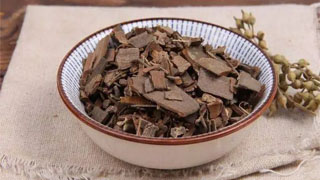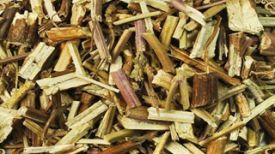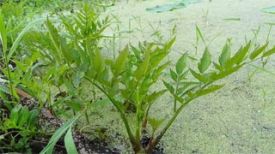
1. Aliases
Four edged trees, ghost arrows, spears, swelling elixirs, and anesthesia.2. Plant morphology
Deciduous shrub, smooth and hairless, with many branches. The small branches are often quadrilateral in shape, with a greenish tint. The robust branches often have flattened cork shaped wings, with wings up to 1 centimeter wide and brown in color. Single leaf opposite, obovate to elliptical or broadly lanceolate, slightly membranous, apex short pointed or acuminate, base acute or wedge-shaped, margin with dense and fine sharp serrations; The upper part is glossy, dark green, and the lower part is light green. It turns red in autumn, and the main veins are slightly raised on both sides of the leaves. The cyme is usually composed of three flowers, which are small, bisexual, and light yellow green; Calyx 4-lobed; Petals 4, nearly circular, sometimes with a microwave like edge; 4 stamens, short filaments, attached to the disk; The ovary is fused with the flower disc. The capsule is oval shaped, with a smooth surface, green or purple green. The seeds are light brown, elliptical or ovate, with an orange red aril covering the outer layer. The flowering period is from May to June, and the fruit ripening period is from September to October.
3. Origin distribution
Born in the mountains or cultivated in gardens. Distributed throughout North China, Central China, East China, and Southwest China.
4. Harvesting and processing
It can be harvested all year round. After cutting the branches, remove the tender branches and leaves, and dry them in the sun. Or collect its winged material and dry it in the sun.
5. Characteristics of medicinal herbs
The branches are slender and cylindrical, with a length of 40-50 centimeters and a diameter of 0.4-1 centimeters. The surface is rough, ranging from dark grayish green to grayish green, with longitudinal wrinkles and grayish white longitudinal pores. There are four cork like wings, flat and flaky, slightly thick near the stem, gradually thinning outward, with a width of 4-10 millimeters. The surface is gray brown to dark brown red, with fine and dense vertical or microwave shaped curved textures, some with horizontal concave lines. Wings are easily peeled off, and common broken marks are found on branches. The branches are hard and tough, with a light yellow white cross-section and fibrous texture. Wings are light and brittle, with a flat cross-section and a brownish yellow color. They are fine grained. Mild Qi, slightly bitter and astringent taste.
6. Nature, taste, and meridian tropism
Cold in nature and bitter in taste. Gui Gan Jing and Pi Jing.
7. Effect and function
Promoting blood circulation and meridians, dispelling blood stasis and relieving pain. It belongs to the subcategory of blood activating and stasis resolving drugs and is classified as blood activating and menstrual regulating drugs.
8. Clinical applications
Dosage 6-10 grams, decoct and take. Used to treat menstrual disorders, postpartum blood stasis and abdominal pain, injuries and swelling caused by falls, and abdominal pain caused by insect infestation.
9. Pharmacological research
It has the function of regulating blood lipids and lowering blood sugar. Animal experiments have shown that water decoction has a hypoglycemic effect. In clinical practice, it is given orally to diabetic patients, 100~1000 mg, with certain curative effect.
10. Chemical composition
Contains steroid compounds such as epi free terpenoids, free terpenoids, quercetin, celastrol, colchicine, triptolide, oleic acid, linoleic acid, linolenic acid, hexanoic acid, acetic acid, benzoic acid, stigmaster-4-en-3-one, stigmaster-4-en-3-one, 6-dione, 6-β - hydroxystigmaster-4-en-3-one, β - sitosterol, as well as flavonoids such as coumarin, D-catechin, and dihydrocatechins.
11. Taboos for use
Pregnant women and those with qi deficiency and metrorrhagia are prohibited from taking medication.
12. Compatibility prescription
① Treating menstrual disorders: 15 grams of ghost arrow feather stem branches. Boil in water and take with brown sugar. (Hunan Pharmacology)
② Treatment for blood avalanche: 10 grams of Ghost Arrow Feather, 10 grams of Angelica sinensis, and 10 grams of Licorice. Boil in water, take twice a day. (Northeast Medicinal Plants)
③ Treatment of nephritis: 60g of ghost arrow feather stem skin. Boil the juice in water, mix the medicinal juice with egg tea and drink. (Henan Chinese Herbal Medicine Handbook)
④ Treating colds: 30g of stem and branch of Euonymus japonicus. Boiled in water. (Fujian Pharmacopoeia)
⑤ Treating dry cough: 30g each of Ghost Arrow Feather and Red Date, decoct and take. (Zhejiang Folk Herbs)
The content of the article is for clinical reference only. Non professionals in traditional Chinese medicine are not allowed to try medication.


